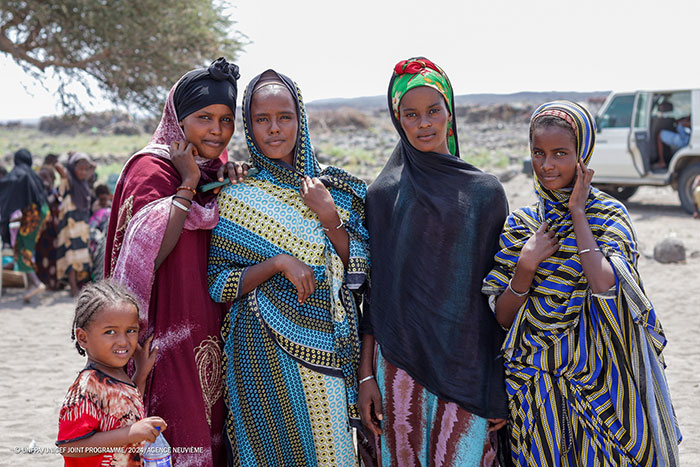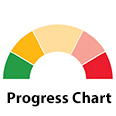Gender equality

Women and girls in Tadjourah, Djibouti, where a communityled movement has successfully lobbied to end female genital mutilation.
© UNFPA-UNICEF Joint Programme on the Elimination of FGMresponsive policy packages that strengthen legal frameworks, reduce economic and structural barriers and scale up investment in gender equality at all levels.
Continuing legal reforms show progress, but gaps remain in all areas
Significant progress in advancing women’s rights has been recorded globally, with 99 positive legal reforms implemented between 2019 and 2024 to remove discriminatory laws and establish gender equality frameworks. Most reforms targeted employment and economic benefits, including lifting work restrictions, guaranteeing equal pay and providing maternity leave, as well as strengthening protections against domestic violence.
Despite this progress, data from 131 countries in 2024 reveal substantial challenges remain. No country achieves a perfect score across all four areas measured: legal frameworks and public life, violence against women, employment and economic benefit, and marriage and family. Over half of the countries (51 per cent) have gaps in each area. Critical restrictions persist: 61 countries (47 per cent) maintain at least one restriction preventing women from performing the same jobs as men. Only 38 countries (29 per cent) establish 18 years as the minimum marriage age without exceptions, and just 63 countries (48 per cent) have rape laws based on lack of consent.
Despite progress in certain countries, child marriage and female genital mutilation remain a reality
Today, nearly one in five young women aged 20–24 (19 per cent) were first married or in a union before age 18. While child marriage has become less common globally, largely due to progress in Southern Asia, levels remain highest in sub-Saharan Africa (31 per cent). Unlike the global trend, its growing share of the world’s child brides is projected to see an increase in absolute numbers by 2030, driven by slow progress and rapid population growth.
Globally, over 230 million girls and women have undergone female genital mutilation (FGM). Africa accounts for more than 144 million cases, followed by Asia with over 80 million and the Middle East with 6 million. Each year, 4 million girls undergo FGM, with over 2 million before age 5. Despite progress in countries such as Benin, Burkina Faso, Kenya and Sierra Leone, eliminating FGM by 2030 will require accelerating progress to 27 times the pace of the past decade.
Gender inequality in land ownership and weak legal protection are persistent barriers to women’s empowerment
Secure land rights are vital for empowering rural women and strengthening agrifood systems. Women with secure tenure are more likely to invest, innovate, boost productivity and lift their families out of poverty. A global review of 84 countries shows that 58 per cent lack adequate legal protections for women’s land rights across family, inheritance and land laws. Many laws remain outdated, fragmented and misaligned with constitutional and international standards.
In nearly 80 per cent of countries with data, fewer than half of women have ownership or secure rights to agricultural land. In nearly half of these countries, men are at least twice as likely to own land as women. Addressing both legal and practical gaps through comprehensive reforms and targeted interventions is crucial, particularly for marginalized groups, including indigenous women, ethnic and religious minorities, widows, and unmarried or divorced women. These efforts must also recognize land rights' critical role in climate change mitigation and resilience.
Proportion of countries with protections for women’s land rights in their national legal framework, by level of protection, 2025 (percentage)

Note: This chart provides an overview of the level of legal protection based solely on de jure measures from 84 countries.
2024’s super election did little for gender parity in politics, revealing the need for bold reforms
As of 1 January 2025, women held 27.2 per cent of the seats in national parliaments; this is up 4.9 percentage points from 2015 but only 0.3 points from 2024, marking a slowdown compared to the average annual increase of nearly 0.5 points in the previous decade. Women’s representation in local government stagnated at 35.5 per cent after an average annual increase of 0.4 points since 2020.
The 2024 “super election” year was a missed opportunity to advance inclusive parliamentary representation and leadership. Although 59 countries renewed their parliaments with a turnover of over 12,000 seats, the share of women and youth in parliament saw little change. A bright spot is the more balanced male-to-female ratio among younger members of parliament (57:43 for under age 30; 63:37 for under age 40). This suggests a more gender-balanced future as younger members advance into leadership positions.
These findings highlight the need for bold reforms to challenge institutional and cultural barriers in politics. Potential game-changing measures include well-designed, ambitious quotas for elections and for appointments to leadership positions, as well as laws and policies of zero-tolerance for violence against women in politics.
Proportion of seats held by women in parliament, 2015 and 2025, and in local government, 2020 and 2024 (percentage)

Proportion of women and men in parliament, by age group, 1 January 2025 (percentage)

Less than one third of managerial positions were held by women
Globally, women occupy less than a third of managerial positions. From 2015 to 2023, their representation increased by only 2.4 percentage points, reaching 30 per cent. At this pace, achieving gender parity in management will take nearly 100 years.
Progress varies dramatically by region. Australia and New Zealand and sub-Saharan Africa lead with over 40 per cent of women in managerial roles, followed by Europe and Northern America, and Latin America and the Caribbean at around 39 per cent. Meanwhile, Central and Southern Asia shows an alarming decline: from 15.1 per cent in 2015 to 11.6 per cent in 2023. Eastern and South-Eastern Asia also reversed progress (-2.3 percentage points), while in Northern Africa and Western Asia, fewer than one in five managerial roles are held by women despite a 6.7 percentage-point increase since 2015. Systemic barriers to employment and career advancement remain prevalent in these regions.
Time-use data reveal persistent gender roles and unequal distribution of care and domestic chores
Women and girls continue to bear a disproportionate share of unpaid domestic and care work, Global time-use data underscore a persistent reality: on average, women devote two and a half times as many hours per day to these tasks as men. Women in Northern Africa and Western Asia spend over four times as many hours as men, while women in Oceania and Europe and Northern America spend approximately twice as many hours. The burden is particularly pronounced among the poorest households, where limited resources prevent outsourcing tasks or investing in time-saving tools.
This unequal distribution reinforces existing gender roles, limiting women’s economic opportunities and perpetuating their marginalization in political, economic and social spheres. Addressing this imbalance requires policies such as improved social protection, investment in care infrastructure and family-friendly labour regulations to redistribute care responsibilities and support women’s economic participation. Without sustained action, both their rights and their potential will remain constrained.
Millions of women lack full decision-making power over their sexual and reproductive health
Despite global commitments, only 56.3 per cent of women aged 15–49 who are married or in a union have full decision-making power over their sexual and reproductive health and rights, according to data from 78 countries. Regional disparities are stark, from just 36.8 per cent in sub-Saharan Africa to 87.2 per cent in Europe. While 88.5 per cent of women can decide on contraceptive use, only 75.4 per cent can refuse sex, and 75 per cent can make healthcare decisions. Eastern and Southern Africa have seen progress, while many countries in Western and Central Africa have experienced significant regression. Educational and urban-rural disparities further hinder progress. The stagnation of progress highlights the urgent need to strengthen legal frameworks, expand access to services and implement locally tailored, data-driven policies. Without sustained action, millions of women will continue to be denied agency over their bodies, compromising their rights, health and well-being.
Despite progress towards gender parity for mobile phone ownership, disparities persist in critical regions
In 2024, four out of five people aged 10 and older globally owned a mobile phone. Universal ownership (over 95 per cent) has been reached in Australia and New Zealand, and Europe and Northern America. Globally, 77 per cent of women owned a mobile phone, compared to 82 per cent of men, resulting in a gender parity score of 0.93. The gender gap is particularly wide in sub-Saharan Africa, Central and Southern Asia, LDCs, and LLDCs, where parity scores fall below 0.82. Notably, SIDS have nearly closed the gender gap in mobile phone ownership and reached full parity in Internet use, despite having only two-thirds Internet penetration. Since 2021, the gender gap in mobile phone ownership has narrowed, from 9.4 to 7 per cent in 2024. However, among the population without mobile phones, there are nearly 800 million women compared to 600 million men.

